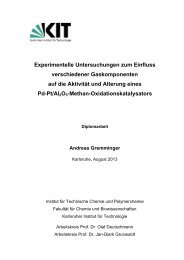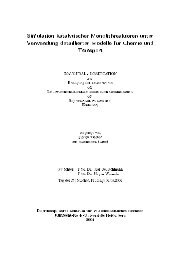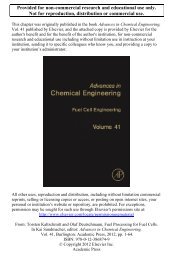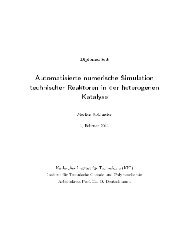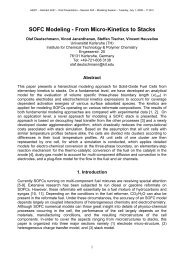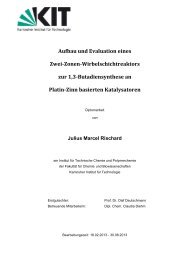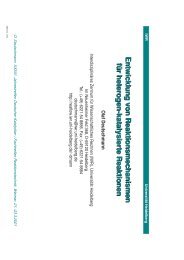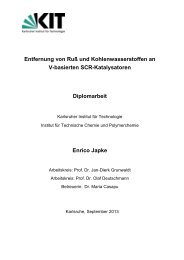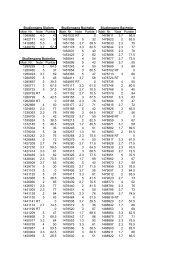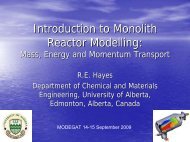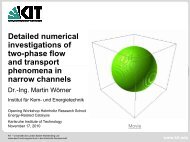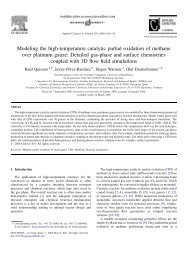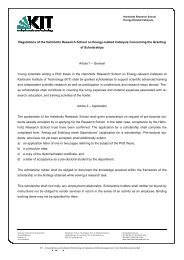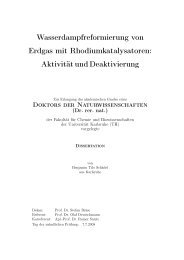Natural Gas Conversion in Monolithic Catalysts - Schwiedernoch.de
Natural Gas Conversion in Monolithic Catalysts - Schwiedernoch.de
Natural Gas Conversion in Monolithic Catalysts - Schwiedernoch.de
Create successful ePaper yourself
Turn your PDF publications into a flip-book with our unique Google optimized e-Paper software.
<strong>Natural</strong> <strong>Gas</strong> <strong>Conversion</strong> VI, Studies <strong>in</strong> Surface Science and Catalysis 136, E. Iglesia, J.J. Spivey, T.H.<br />
Fleisch (eds.), p. 251-258, Elsevier, 2001.<br />
<strong>Natural</strong> <strong>Gas</strong> <strong>Conversion</strong> <strong>in</strong> <strong>Monolithic</strong> <strong>Catalysts</strong>: Interaction of Chemical<br />
Reactions and Transport Phenomena<br />
Olaf Deutschmann, Renate <strong>Schwie<strong>de</strong>rnoch</strong>, Luba I. Maier, Daniel Chatterjee<br />
Interdiscipl<strong>in</strong>ary Center for Scientific Comput<strong>in</strong>g (IWR), Hei<strong>de</strong>lberg University<br />
Im Neuenheimer Feld 368, D-69120 Hei<strong>de</strong>lberg, Germany<br />
Abstract<br />
The <strong>in</strong>teraction of transport and k<strong>in</strong>etics <strong>in</strong> catalytic monoliths used for natural gas conversion is<br />
studied experimentally and numerically. The paper focuses on a precise flow field agreement between<br />
experiment and mo<strong>de</strong>l. Therefore, we use extru<strong>de</strong>d monoliths with rectangular channel cross-section<br />
and a three-dimensional Navier-Stokes simulation <strong>in</strong>clud<strong>in</strong>g <strong>de</strong>tailed reaction mechanisms and a heat<br />
balance. Latter also accounts for heat conduct<strong>in</strong>g channel walls and external heat loss. If a washcoat is<br />
used, a set of one-dimensional reaction-diffusion equations is additionally applied for mo<strong>de</strong>l<strong>in</strong>g the<br />
transport and heterogeneous reactions <strong>in</strong> the washcoat. Partial oxidation of methane to synthesis gas<br />
on rhodium coated monoliths has been studied as example.<br />
1. INTRODUCTION<br />
<strong>Monolithic</strong> catalysts are often applied for natural gas conversion processes such as partial<br />
oxidation of light alkanes [1, 2] and catalytic combustion [3, 4]. In particular at short contact<br />
times, a complex <strong>in</strong>teraction of transport and reaction k<strong>in</strong>etics can occur. Chemical reactions<br />
can not only take place on the catalytic surface but also <strong>in</strong> the gas phase as was shown for<br />
partial oxidation of methane on rhodium at elevated pressure [5] and oxy-<strong>de</strong>hydrogenation of<br />
ethane on plat<strong>in</strong>um at atmospheric pressure [6]. In those studies, computational tools for the<br />
numerical simulation of heterogeneous reactive flows were <strong>de</strong>veloped and applied to a twodimensional<br />
simulation of a s<strong>in</strong>gle-channel <strong>in</strong> a foam monolith. In that work, the complex<br />
shape of the pores of the foam monolith was <strong>de</strong>scribed by us<strong>in</strong>g the simplified mo<strong>de</strong>l of a<br />
straight tube. A three-dimensional simulation of the catalytic partial oxidation of methane to<br />
synthesis gas <strong>in</strong> a wire gauze configuration has been previously performed by <strong>de</strong> Smet et al.<br />
[7] but a simple surface reaction mo<strong>de</strong>l was used.<br />
The un<strong>de</strong>rstand<strong>in</strong>g of the <strong>de</strong>tails of the reactor behavior <strong>de</strong>mands a better agreement<br />
between experimental and mo<strong>de</strong>led flow field without neglect<strong>in</strong>g the complex chemistry.<br />
Therefore, our present work focuses on sett<strong>in</strong>g up an a<strong>de</strong>quate experiment where we use<br />
extru<strong>de</strong>d monoliths with straight channels with rectangular cross-section. The mo<strong>de</strong>l then<br />
applies a three-dimensional flow field <strong>de</strong>scription coupled with <strong>de</strong>tailed reaction mechanisms<br />
and an enthalpy govern<strong>in</strong>g equation that <strong>in</strong>clu<strong>de</strong>s a heat conduct<strong>in</strong>g channel wall.
The <strong>in</strong>ner walls of the s<strong>in</strong>gle channels of extru<strong>de</strong>d monoliths are frequently coated with a th<strong>in</strong><br />
layer of washcoat to enlarge the surface. Here, diffusion of reactants and products to and from<br />
the catalytic active centers <strong>in</strong> the washcoat can limit the total heterogeneous reaction rate [8].<br />
Therefore, a set of one-dimensional reaction-diffusion equations is applied to account for<br />
washcoat diffusion <strong>in</strong> the numerical simulation of the monolithic catalyst.<br />
As an example we will discuss experiments and numerical simulations carried out for the<br />
partial oxidation of methane to synthesis gas on a rhodium coated extru<strong>de</strong>d monolith.<br />
2. EXPERIMENTAL<br />
The experimental set up was <strong>de</strong>signed <strong>in</strong> a way that allows the application of <strong>de</strong>tailed mo<strong>de</strong>ls<br />
for the physical and chemical processes occurr<strong>in</strong>g <strong>in</strong> the reactor. Experiments were carried out<br />
<strong>in</strong> a tubular quartz reactor, 25 cm long and 2.6 cm <strong>in</strong> (<strong>in</strong>ner) diameter. The tube conta<strong>in</strong>s a<br />
1cm long extru<strong>de</strong>d monolith with a well-<strong>de</strong>f<strong>in</strong>ed rectangular cross-section (1mm x 1mm) of<br />
its channels. The ceramic monolith ma<strong>de</strong> of cordierite is coated with the noble metal rhodium<br />
by saturation with an acidic aqueous solution of Rh 2 (SO 4 ) 3 , 24 hours dry<strong>in</strong>g at 100°C,<br />
reduction <strong>in</strong> H 2 at 500°C, and calc<strong>in</strong>ation <strong>in</strong> air at 500°C for 18 hours. Metal load<strong>in</strong>gs are 1 to<br />
3% Rh by weight. Energy dispersive X-ray spectroscopy (EDX) pictures revealed that no<br />
sulfur compounds are left on the surface from the impregnation process. For the <strong>in</strong>vestigation<br />
of washcoat diffusion, cordierite monoliths pre-coated with an alum<strong>in</strong>a washcoat are used.<br />
The entire reactor can be run either auto-thermally or temperature-controlled by a furnace.<br />
The gas temperature at the exit of the catalytic monolith is <strong>de</strong>term<strong>in</strong>ed by a thermocouple<br />
placed <strong>in</strong>si<strong>de</strong> a th<strong>in</strong> quartz tube to prevent catalytic reactions. Because of heat losses to the<br />
ambience, the measured exit temperature was always significantly lower than the adiabatic<br />
reactor temperature would be.<br />
1.0<br />
1.0<br />
1300<br />
0.8<br />
CO<br />
0.8<br />
O 2<br />
1200<br />
T peak<br />
Selectivity<br />
0.6<br />
0.4<br />
0.2<br />
H 2<br />
H 2<br />
O<br />
<strong>Conversion</strong><br />
0.6<br />
0.4<br />
0.2<br />
CH 4<br />
1100<br />
1000<br />
900<br />
p [ ]<br />
T exit<br />
CO 2<br />
0.0<br />
0.0<br />
1.4 1.6 1.8 2.0 2.2 2.4<br />
Inlet mole ratio CH 4<br />
/O 2<br />
1.4 1.6 1.8 2.0 2.2<br />
Inlet mole ratio CH 4<br />
/O 2<br />
800<br />
Fig. 1. Effect of methane/oxygen ratio on selectivity, conversion, and peak (simulation) and<br />
outlet temperature; symbols = experiment, l<strong>in</strong>es = simulation. No washcoat is used.
The product composition is <strong>de</strong>term<strong>in</strong>ed by gas chromatography (TCD, FID) and by<br />
quadrupole mass spectroscopy. The latter one can also be used for transient measurements,<br />
for <strong>in</strong>stants for studies of ignition and ext<strong>in</strong>ction phenomena. The reactor is operated at<br />
atmospheric pressure (1.1 bar). The total feed flow rate corresponds to a resi<strong>de</strong>nce time of few<br />
milliseconds.<br />
Methane/oxygen mixtures were fed diluted by argon. In the experiment, we have been<br />
study<strong>in</strong>g the effect of composition, flow rate, dilution, and preheat on selectivity and<br />
conversion. Exemplary, Fig. 1 exhibits selectivity, conversion, and outlet temperature as<br />
function of the methane/oxygen ratio. A good agreement is shown between experimentally<br />
<strong>de</strong>term<strong>in</strong>ed and numerically predicted data, the latter achieved by the mo<strong>de</strong>l discussed below.<br />
3. MODELING THE MONOLITH CHANNEL<br />
Even though the experimental measurements reveal that significant heat loss occurs, we<br />
simply assume for the mo<strong>de</strong>l that every channel of the monolith behaves essentially alike.<br />
Thus radial profiles over the monolith as a whole are neglected, and only one s<strong>in</strong>gle channel<br />
has to be analyzed. The flow with<strong>in</strong> these small diameter channels is lam<strong>in</strong>ar. Because an<br />
objective of this study is an appropriate agreement between experimental configuration and<br />
flow field mo<strong>de</strong>l, we solve the three-dimensional Navier-Stokes equations for the simulation<br />
of the rectangular shaped channel. These equations are coupled with an energy conservation<br />
equation and an additional conservation equation for each chemical species. The energy<br />
conservation equation accounts for heat transport by convection and conduction <strong>in</strong> the gas<br />
phase, heat release due to chemical reactions <strong>in</strong> the gas phase and on the catalytic surface, and<br />
heat conduction <strong>in</strong> the channel walls. Furthermore, we ad<strong>de</strong>d an external heat loss term at the<br />
outer boundary of the channel wall to account for the experimentally occurr<strong>in</strong>g heat loss. The<br />
temperature-<strong>de</strong>pen<strong>de</strong>nt external heat loss was specified so that the predicted outlet<br />
temperature agrees with the experimentally measured temperature. Because selectivity and<br />
conversion <strong>in</strong> catalytic partial oxidation of light alkanes strongly <strong>de</strong>pend on the spatial<br />
temperature profile, the <strong>de</strong>tailed <strong>de</strong>scription of the energy balance is crucial for the<br />
un<strong>de</strong>rstand<strong>in</strong>g of the reaction.<br />
The chemical reactions are mo<strong>de</strong>led by <strong>de</strong>tailed reaction schemes for homogeneous as well<br />
as heterogeneous reactions. In the heterogeneous reaction mo<strong>de</strong>l we apply the mean field<br />
approximation. That means that the adsorbates are assumed to be randomly distributed on the<br />
surface, which is viewed as be<strong>in</strong>g uniform. The state of the catalytic surface is <strong>de</strong>scribed by<br />
the temperature T and a set of surface coverages Θ<br />
i<br />
, both <strong>de</strong>pend<strong>in</strong>g on the macroscopic<br />
position <strong>in</strong> the reactor, but averag<strong>in</strong>g over microscopic local fluctuations. Balance equations<br />
are established to couple the surface processes with the surround<strong>in</strong>g reactive flow. The<br />
production rates s& i<br />
of surface and gas phase species (due to adsorption and <strong>de</strong>sorption) is then<br />
written as<br />
∑<br />
Ks<br />
k = 1<br />
∏<br />
N g + N<br />
i=<br />
1<br />
ν ′<br />
i<br />
s ik<br />
s& = ν k ( c )<br />
(1)<br />
i<br />
i<br />
k<br />
f<br />
k
with K s<br />
= number of surface reactions <strong>in</strong>clud<strong>in</strong>g adsorption and <strong>de</strong>sorption, ν<br />
i<br />
, ν ′<br />
k i<br />
= stoichiometric<br />
coefficients, k<br />
k<br />
f<br />
= forward rate coefficient, N ( )<br />
k<br />
g<br />
N<br />
s<br />
= number of gaseous (surface)<br />
species, c<br />
i<br />
= concentration of species i, which is given <strong>in</strong> mol cm -2 for adsorbed species.<br />
Because the b<strong>in</strong>d<strong>in</strong>g states of adsorption on the surface vary with the surface coverage of all<br />
adsorbed species, the expression for the rate coefficient becomes complex:<br />
k<br />
f<br />
k<br />
⎡− Ea<br />
⎤ N ⎡ε<br />
i<br />
Θ<br />
β<br />
i ⎤<br />
k<br />
k<br />
s ik<br />
k<br />
= Ak<br />
T exp ⎢ ⎥ ∏ =<br />
Θ µ<br />
⎢ ⎥<br />
⎣ RT<br />
i i<br />
exp<br />
(2)<br />
1<br />
⎦<br />
⎣ RT ⎦<br />
A<br />
k<br />
= preexponential factor,<br />
with<br />
reaction k. Coefficients<br />
µ<br />
i<br />
and<br />
k<br />
β<br />
k<br />
= temperature exponent, and<br />
ε<br />
i<br />
k<br />
E<br />
a k<br />
= activation energy of<br />
<strong>de</strong>scribe the <strong>de</strong>pen<strong>de</strong>nce of the rate coefficients on the<br />
surface coverage of species i. For adsorption reactions, stick<strong>in</strong>g coefficients are commonly<br />
used. They are converted to conventional rate coefficients by<br />
0<br />
Si<br />
RT<br />
ads = (3)<br />
Γ τ 2π<br />
M<br />
k<br />
f k<br />
i<br />
0<br />
with S<br />
i<br />
= <strong>in</strong>itial stick<strong>in</strong>g coefficient, Γ = surface site <strong>de</strong>nsity <strong>in</strong> mol cm -2 , τ = number of<br />
sites occupied by the adsorb<strong>in</strong>g species, M<br />
i<br />
= molar mass of species i. While the surface site<br />
<strong>de</strong>nsity can be estimated from the catalyst material, the knowledge of the ratio of the active<br />
catalytic surface area to geometrical surface area is essential for the mo<strong>de</strong>l. An exact value for<br />
this ratio has to be <strong>de</strong>term<strong>in</strong>ed experimentally. In the simulation discussed here we simply use<br />
a value of unity, and the surface site <strong>de</strong>nsity for rhodium is set to be 2.7·10 -9 mol cm -2 .<br />
In spite of numerous surface science studies on H 2 , CO and hydrocarbon oxidation there is<br />
still a substantial lack <strong>in</strong> k<strong>in</strong>etic data. Nevertheless, several surface reaction mechanisms with<br />
associated rate expressions have been published for complete and partial oxidation on noble<br />
metal catalysts <strong>in</strong> the last <strong>de</strong>ca<strong>de</strong>. Even though the mechanisms are often based on few<br />
experimental data, which were achieved for a limited range of conditions, they led to a better<br />
un<strong>de</strong>rstand<strong>in</strong>g of the process.<br />
In the present study, the surface chemistry is <strong>de</strong>scribed by a <strong>de</strong>tailed surface reaction<br />
mechanism that is un<strong>de</strong>r <strong>de</strong>velopment for the <strong>de</strong>scription of partial as well as complete<br />
oxidation of methane on rhodium [9]. The mechanism consists of 38 reactions among 6 gas<br />
phase species and further 11 adsorbed species, as shown <strong>in</strong> Table 1. Because the surface<br />
coverage is low for the conditions chosen <strong>in</strong> the present study, the <strong>de</strong>pen<strong>de</strong>nce of the rate<br />
coefficients on the surface coverage was neglected. However, it may become important at<br />
different conditions. For more <strong>de</strong>tails, we refer to a forthcom<strong>in</strong>g paper <strong>in</strong> which the<br />
establishment of the reaction mechanism will be discussed [9]. We would like to note that the<br />
present study does not focus on the <strong>de</strong>velopment of the surface reaction mechanism but rather
on its application <strong>in</strong> multi-dimensional simulations that allow to <strong>de</strong>scribe the reactor behavior<br />
as a<strong>de</strong>quate as possible.<br />
TABLE 1: SURFACE REACTION MECHANISM<br />
A E a<br />
(1) H 2 + 2 Rh(s) ⇒ 2 H(s) 1.00·10 -02 s.c.<br />
(2) O 2 + 2 Rh(s) ⇒ 2 O(s) 1.00·10 -02 s.c.<br />
(3) CH 4 + Rh(s) ⇒ CH 4 (s) 8.00·10 -03 s.c.<br />
(4) H 2 O + Rh(s) ⇒ H 2 O(s) 1.00·10 -01 s.c.<br />
(5) CO 2 + Rh(s) ⇒ CO 2 (s) 1.00·10 -05 s.c.<br />
(6) CO + Rh(s) ⇒ CO(s) 5.00·10 -01 s.c.<br />
(7) 2 H(s) ⇒ 2 Rh(s) + H 2 3.00·10 +21 77.8<br />
(8) 2 O(s) ⇒ 2 Rh(s) + O 2 1.30·10 +22 355.2<br />
(9) H 2 O(s) ⇒ H 2 O + Rh(s) 3.00·10 +13 45.0<br />
(10) CO(s) ⇒ CO + Rh(s) 3.50·10 +13 133.4<br />
(11) CO 2 (s) ⇒ CO 2 + Rh(s) 1.00·10 +13 21.7<br />
(12) CH 4 (s) ⇒ CH 4 + Rh(s) 1.00·10 +13 25.1<br />
(13) O(s) + H(s) ⇒ OH(s) + Rh(s) 5.00·10 +22 83.7<br />
(14) OH(s) + Rh(s) ⇒ O(s) + H(s) 3.00·10 +20 37.7<br />
(15) H(s) + OH(s) ⇒ H 2 O(s) + Rh(s) 3.00·10 +20 33.5<br />
(16) Rh(s) + H 2 O(s) ⇒ H(s) + OH(s) 5.00·10 +22 104.7<br />
(17) OH(s) + OH(s) ⇒ H 2 O(s) + O(s) 3.00·10 +21 100.8<br />
(18) O(s) + H 2 O(s) ⇒ OH(s) + OH(s) 3.00·10 +21 171.8<br />
(19) C(s) + O(s) ⇒ CO(s) + Rh(s) 3.00·10 +22 97.9<br />
(20) CO(s) + Rh(s) ⇒ C(s) + O(s) 2.50·10 +21 169.0<br />
(21) CO(s) + O(s) ⇒ CO 2 (s) + Rh(s) 1.40·10 +20 121.6<br />
(22) CO 2 (s) + Rh(s) ⇒ CO(s) + O(s) 3.00·10 +21 115.3<br />
(23) CH 4 (s) + Rh(s) ⇒ CH 3 (s) + H(s) 3.70·10 +21 61.0<br />
(24) CH 3 (s) + H(s) ⇒ CH 4 (s) + Rh(s) 3.70·10 +21 51.0<br />
(25) CH 3 (s) + Rh(s) ⇒ CH 2 (s) + H(s) 3.70·10 +24 103.0<br />
(26) CH 2 (s) + H(s) ⇒ CH 3 (s) + Rh(s) 3.70·10 +21 44.0<br />
(27) CH 2 (s) + Rh(s) ⇒ CH(s) + H(s) 3.70·10 +24 100.0<br />
(28) CH(s) + H(s) ⇒ CH 2 (s) + Rh(s) 3.70·10 +21 68.0<br />
(29) CH(s) + Rh(s) ⇒ C(s) + H(s) 3.70·10 +21 21.0<br />
(30) C(s) + H(s) ⇒ CH(s) + Rh(s) 3.70·10 +21 172.8<br />
(31) CH 4 (s) + O(s) ⇒ CH 3 (s) + OH(s) 1.70·10 +24 80.3<br />
(32) CH 3 (s) + OH(s) ⇒ CH 4 (s) + O(s) 3.70·10 +21 24.3<br />
(33) CH 3 (s) + O(s) ⇒ CH 2 (s) + OH(s) 3.70·10 +24 120.1<br />
(34) CH 2 (s) + OH(s) ⇒ CH 3 (s) + O(s) 3.70·10 +21 15.1<br />
(35) CH 2 (s) + O(s) ⇒ CH(s) + OH(s) 3.70·10 +24 158.4<br />
(36) CH(s) + OH(s) ⇒ CH 2 (s) + O(s) 3.70·10 +21 36.8<br />
(37) CH(s) + O(s) ⇒ C(s) + OH(s) 3.70·10 +21 30.1<br />
(38) C(s) + OH(s) ⇒ CH(s) + O(s) 3.70·10 +21 145.5<br />
The units of A are given <strong>in</strong> terms of [mol, cm, s] and of E a <strong>in</strong> [kJ/mol].<br />
s.c. = <strong>in</strong>itial stick<strong>in</strong>g coefficient.<br />
If the <strong>in</strong>ner walls of the s<strong>in</strong>gle channels are coated with a th<strong>in</strong> layer of washcoat the catalytic<br />
active surface area can easily be <strong>in</strong>creased by a factor of 10 2 -10 3 <strong>in</strong> comparison to the<br />
geometrical surface area of the <strong>in</strong>ner wall of the monolith channel. Diffusion and reaction
with<strong>in</strong> the washcoat pores leads to local concentration gradients that have to be resolved to<br />
calculate the total heterogeneous reaction rate. Therefore, we apply a set of one-dimensional<br />
reaction-diffusion equations to calculate the species concentrations and surface coverages<br />
with<strong>in</strong> the washcoat as function of the distance (r) from the gas-washcoat <strong>in</strong>terface:<br />
∂<br />
∂<br />
ji<br />
−γ s&<br />
i<br />
= 0 . (4)<br />
r<br />
Here, s&<br />
i<br />
= local molar reaction rate of gas phase species i due to adsorption and <strong>de</strong>sorption,<br />
γ = active catalytic surface area / washcoat volume, j i = mass diffusion flux of species i.<br />
Depend<strong>in</strong>g on the washcoat structure molecular or Knudsen diffusion coefficients have to be<br />
used. The number of coupled nonl<strong>in</strong>ear reaction-diffusion equations equals the number of gas<br />
phase species. In addition to this equation set, one additional algebraic equation, s&<br />
i<br />
= 0 , has<br />
to be solved for each surface species. The equation simply says that the surface coverage has<br />
to be constant when the steady state is reached.<br />
The numerical simulation is based on the computational fluid dynamics co<strong>de</strong> FLUENT<br />
[10] which was coupled to the chemistry tool DETCHEM [5, 11] via FLUENT’s <strong>in</strong>terface for<br />
user <strong>de</strong>f<strong>in</strong>ed subrout<strong>in</strong>es. DETCHEM mo<strong>de</strong>ls the chemical processes <strong>in</strong> the gas phase and on<br />
the surface <strong>in</strong>clud<strong>in</strong>g the surface coverage calculation based on multi-step chemical reaction<br />
mechanisms. Additionally, several washcoat mo<strong>de</strong>ls can be <strong>in</strong>clu<strong>de</strong>d [12]. Due to symmetry,<br />
only an eighth of the channel cross section has to be simulated, for numerical reasons we<br />
simulated a quarter <strong>in</strong>stead.<br />
4. RESULTS AND DISCUSSION<br />
The s<strong>in</strong>gle channel of the catalytic monolith is simulated un<strong>de</strong>r conditions as chosen <strong>in</strong> the<br />
experiment. The methane/oxygen mixture, diluted by 75 vol.% argon, flows at 300 K and 1.1<br />
bar with a uniform velocity of 0.26 m/s (correspond<strong>in</strong>g to 7 slpm over the whole monolith) <strong>in</strong><br />
the rectangular shaped monolith channel. The simulated channel is 1.1 cm <strong>in</strong> length with the<br />
first millimeter be<strong>in</strong>g non-catalytic. In the simulation and <strong>in</strong> the experiment, the reaction has<br />
to be ignited. In the experiment the reactor is <strong>in</strong>si<strong>de</strong> a furnace which is heated up to <strong>in</strong>itiate<br />
the reaction; after ignition the furnace is switched off, the reactor is operated auto-thermally.<br />
In the simulation, the channel wall is given a sufficiently high temperature to ignite the<br />
reaction. Then, a heat conduct<strong>in</strong>g wall is assumed <strong>in</strong>clud<strong>in</strong>g external heat loss.<br />
In Figure 1, a good agreement is shown between experimentally <strong>de</strong>term<strong>in</strong>ed and computed<br />
selectivity and conversion. The syngas selectivity and methane conversion are lower than the<br />
data reported by the Schmidt group [1] due to significant heat loss <strong>in</strong> the reactor. The<br />
computed peak temperature is much higher than the exit temperature, not only due to heat loss<br />
but also due to endothermic steam reform<strong>in</strong>g.<br />
The three-dimensional simulation <strong>in</strong>clud<strong>in</strong>g the <strong>de</strong>tailed reaction mechanisms allows us to<br />
study this behavior <strong>in</strong> more <strong>de</strong>tail. In previous studies [5], we used the surface reaction<br />
mechanism proposed by Hickman and Schmidt <strong>in</strong> their pioneer<strong>in</strong>g work <strong>in</strong> 1993 [1], <strong>in</strong> which
steam and CO 2 reform<strong>in</strong>g is not significant. Because of new experimental studies [9], at least<br />
steam reform<strong>in</strong>g seems to be an important reaction step. Among other reasons, this fact led to<br />
the <strong>de</strong>velopment of the revised reaction mechanism. In Figure 2, the profiles of the species<br />
mass fractions for a CH 4 /O 2 vol. ratio of 1.8 reveal fast O 2 consumption at the catalyst lead<strong>in</strong>g<br />
edge while CH 4 is consumed over almost the whole length of the reactor. Complete oxidation<br />
takes place at the catalyst entrance only, where O 2 is still available. Because CH 4 as well as<br />
re-adsorbed H 2 O <strong>de</strong>compose <strong>in</strong>to atoms on the surface (Table 1), it cannot be dist<strong>in</strong>guished<br />
between direct partial oxidation of CH 4 to H 2 or steam reform<strong>in</strong>g. At least further downstream<br />
H 2 is formed via steam reform<strong>in</strong>g only. In contrast to that, CO 2 reform<strong>in</strong>g does not occur. The<br />
temperature profiles exhibit the strong axial and radial gradients due to chemical reactions and<br />
heat transport.<br />
7.3E-02<br />
8.0E-02<br />
CH 4<br />
3.2E-02<br />
O 2<br />
1.8E-05<br />
6.3E-03<br />
0<br />
H 2<br />
4.5E-02<br />
0<br />
H 2<br />
O<br />
6.0E-02<br />
CO<br />
0<br />
1.9E-02<br />
CO 2<br />
0<br />
1.2E+03<br />
T(K)<br />
3.0E+02<br />
Fig. 2. Species mass fractions and temperature <strong>in</strong> the monolith channel (1 mm x 1mm). The<br />
contour plots represent the diagonal face of the simulated channel section reach<strong>in</strong>g from the<br />
<strong>in</strong>ner corner of the catalytic walls to the channel axis; the diagonal coord<strong>in</strong>ate has been<br />
enlarged for visual clarity, the total length is 1.1 cm with the first millimeter be<strong>in</strong>g noncatalytic<br />
(no wall is shown). The lower right figure shows the temperature profiles <strong>in</strong> the<br />
channel wall, the <strong>in</strong>let, and the front symmetry face at the catalyst entrance.
The simulation also reveals that chemical reactions <strong>in</strong> the gas phase are not significant at<br />
atmospheric pressure but become important above 10 bar.<br />
If the monolith is coated with an alum<strong>in</strong>a washcoat, the diameters of the pores are on the<br />
or<strong>de</strong>r of micrometers. Molecular diffusion <strong>in</strong>si<strong>de</strong> the pores can limit the overall reaction rate.<br />
In Figure 3, we exemplary show computed concentration and coverage profiles <strong>in</strong>si<strong>de</strong> the<br />
washcoat at one millimeter beh<strong>in</strong>d the catalyst entrance. Here most of the oxygen is already<br />
consumed, and also the oxygen concentration <strong>in</strong>si<strong>de</strong> the washcoat <strong>de</strong>creases rapidly due to<br />
catalytic reaction with methane. Deeper <strong>in</strong>si<strong>de</strong> the pores, oxygen is vanished and water reacts<br />
with methane to form syngas and carbon dioxi<strong>de</strong>. This behavior expla<strong>in</strong>s why the product<br />
water shows its highest concentration at the washcoat <strong>in</strong>let.<br />
Concentration [mol m -3 ]<br />
0.7<br />
10 0<br />
CH<br />
CO(s)<br />
4<br />
0.6<br />
10 -1<br />
0.5<br />
O(s)<br />
H 2<br />
O<br />
0.4<br />
10 -2<br />
H(s)<br />
CO<br />
0.3<br />
10 -3<br />
C(s)<br />
0.2<br />
H<br />
CO 2<br />
10 -4<br />
H 2<br />
O(s)<br />
0.1 2<br />
O OH(s)<br />
2<br />
0.0<br />
10 -5<br />
0 20 40 60 80 100<br />
0 20 40 60 80 100<br />
Distance [ µ m]<br />
Surface coverage<br />
Distance [ µ m]<br />
Fig. 3. Species concentrations (left) and surface coverage (right) <strong>in</strong>si<strong>de</strong> the washcoat.<br />
Washcoat parameter: thickness = 100 µm, porosity = 0.51, tortousity = 3, γ = 10 5 m -1 .<br />
REFERENCES<br />
1. D. A. Hickman and L. D. Schmidt, AIChE J. 39 (1993) 1164.<br />
2. M. Huff and L. D. Schmidt, J. Catal. 155 (1995) 82.<br />
3. R. E. Hayes and S. T. Kolaczkowski, Introduction to Catalytic Combustion, Gordon and Breach<br />
Science Publ., Amsterdam, 1997.<br />
4. L. L. Raja, R. J. Kee, O. Deutschmann, J. Warnatz, L. D. Schmidt, Catal. Today 59 (2000) 47.<br />
5. O. Deutschmann and L. D. Schmidt, AIChE J. 44 (1998) 2465.<br />
6. D. K. Zerkle, M. D. Allendorf, M. Wolf, O. Deutschmann, J. Catal. 196 (2000) 18.<br />
7. C. R. H. <strong>de</strong> Smet, M.H.J.M. <strong>de</strong> Croon, R.J. Berger, G. B. Mar<strong>in</strong>, J. C. Schouten, Appl. Catal. A<br />
187(1) (1999) 33.<br />
8. D. Papadias, L. Edsberg, P. Björnbom, Catalysis Today 60 (2000) 11.<br />
9. S. Tummala, L. D. Schmidt, O. Deutschmann, publication <strong>in</strong> preparation.<br />
10. Fluent Version. 4.4, Fluent Inc., Lebanon, New Hampshire, 1997.<br />
11. O. Deutschmann, DETCHEM: Computer package for <strong>de</strong>tailed chemistry <strong>in</strong> CFD co<strong>de</strong>s,<br />
http://reaflow.iwr.uni-hei<strong>de</strong>lberg.<strong>de</strong>/˜dmann/DETCHEM.html, 1999.<br />
12. D. Chatterjee, O. Deutschmann, J. Warnatz, Faraday Discussions, accepted for publication.



